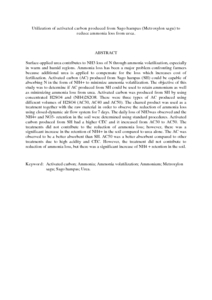Citation
Bernard, Regis and Ahmed, Osumanu Haruna and Nik Ab. Majid, Nik Muhamad
(2011)
Utilization of activated carbon produced from Sago hampas (Metroxylon sagu) to reduce ammonia loss from urea.
International Journal of the Physical Sciences, 6 (25).
pp. 6140-6146.
ISSN 1992-1950
Abstract
Surface-applied urea contributes to NH3 loss of N through ammonia volatilization, especially in warm
and humid regions. Ammonia loss has been a major problem confronting farmers because additional
urea is applied to compensate for the loss which increases cost of fertilization. Activated carbon (AC)
produced from Sago hampas (SH) could be capable of absorbing N in the form of NH4+ to minimize
ammonia volatilization. The objective of this study was to determine if AC produced from SH could be
used to retain ammonium as well as minimizing ammonia loss from urea. Activated carbon was produced from SH by using concentrated H2SO4 and (NH4)2S2O8. There were three types of AC produced using different volumes of H2SO4 (AC30, AC40 and AC50). The charred product was used as a treatment
together with the raw material in order to observe the reduction of ammonia loss using closed-dynamic
air flow system for 7 days. The daily loss of NH3was observed and the NH4+ and NO3- retention in the soil
were determined using standard procedures. Activated carbon produced from SH had a higher CEC and
it increased from AC30 to AC50. The treatments did not contribute to the reduction of ammonia loss;
however, there was a significant increase in the retention of NH4+ in the soil compared to urea alone.
The AC was observed to be a better absorbent than SH. AC50 was a better absorbent compared to other
treatments due to high acidity and CEC. However, the treatment did not contribute to reduction of
ammonia loss, but there was a significant increase of NH4
+ retention in the soil.
Download File
![[img]](http://psasir.upm.edu.my/22190/1.hassmallThumbnailVersion/Utilization%20of%20activated%20carbon%20produced%20from%20Sago%20hampas.pdf)  Preview |
|
PDF (Abstract)
Utilization of activated carbon produced from Sago hampas.pdf
Download (85kB)
| Preview
|
|
Additional Metadata
Actions (login required)
 |
View Item |



